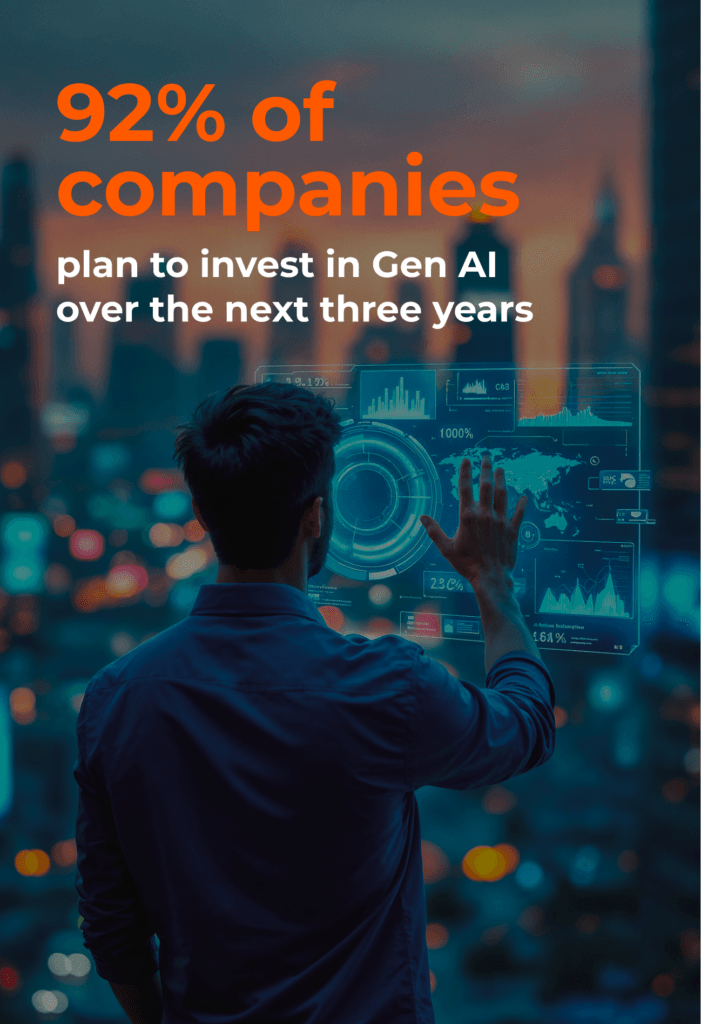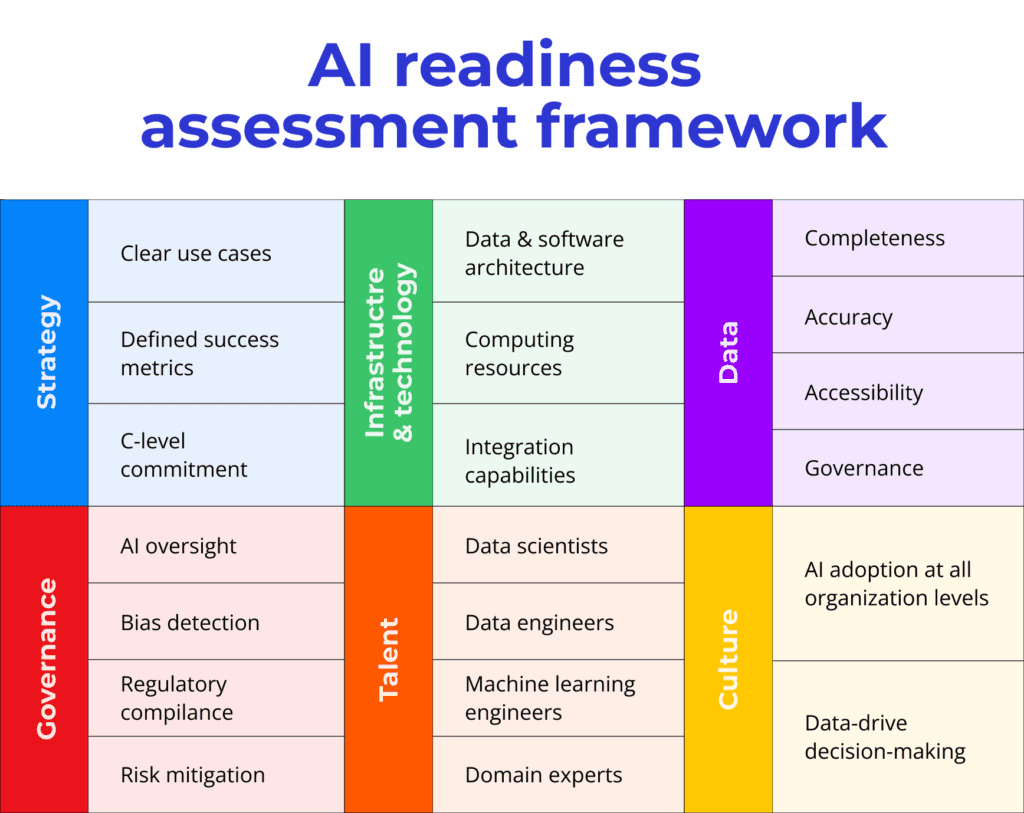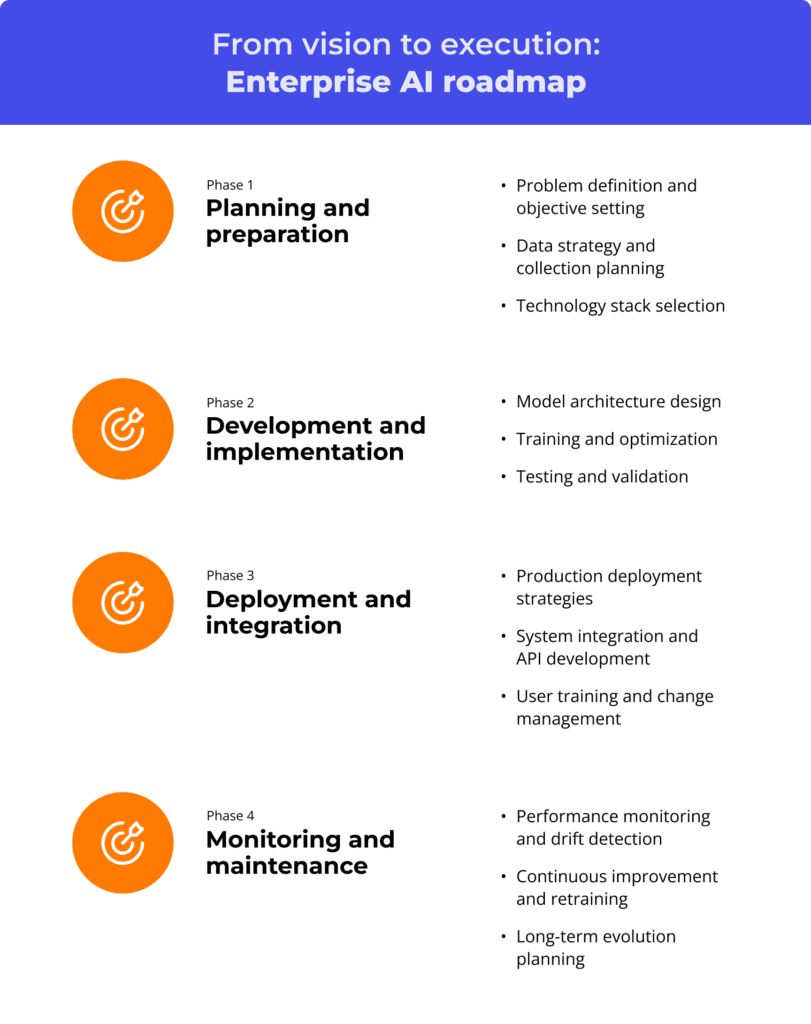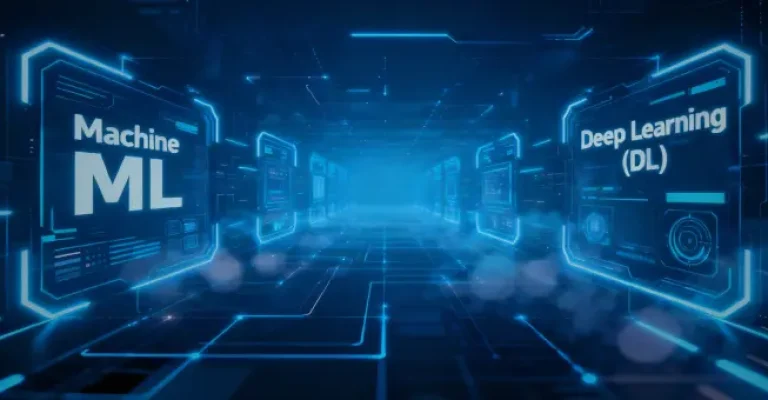Today, organizations have an unprecedented opportunity to leverage AI to augment complex workflows and bring game-changing capabilities to digital products and enterprise tools. One of the most effective ways to harness this potential is by building custom AI solutions tailored to your unique needs. Whether you’re looking to automate processes, gain predictive insights, or enhance user experiences, a well-designed AI system can make a significant impact on your business.
Strategic AI implementation isn’t just about having the latest technology; it also requires a strong ability to align your engineering and business vision. This guide will walk you through the process of planning and building your own AI solution — whether in-house or with the support of external partners. You’ll learn how to assess your readiness, choose and design the right models, manage costs, navigate the AI project process, and ensure your investment remains valuable as technology evolves.
What are custom AI solutions, and how do they compare to off-the-shelf options?
Custom AI solutions are artificial intelligence systems designed specifically around your business’s unique workflows, data, and objectives. Unlike one-size-fits-all AI tools available as commercial SaaS offerings, these systems are purpose-built to address your specific challenges and opportunities.

With 92% of companies planning to invest in Gen AI in 2025, custom AI capabilities have become essential for businesses seeking a competitive advantage or facing unique challenges. Whether it’s analyzing proprietary datasets, integrating with legacy systems, or meeting industry-specific compliance requirements, tailor-made AI solutions provide the precision and flexibility that off-the-shelf solutions lack. That being said, each type of AI solution has strategic advantages and tradeoffs that businesses need to consider when planning strategic adoption.
Custom vs off-the-shelf AI: strategic comparison

When to choose custom AI:
- Your business processes are unique and/or complex
- You have proprietary data that provides competitive advantage
- Compliance and data privacy are critical concerns
- You need seamless integration with existing systems
- Long-term differentiation is a priority
When off-the-shelf works:
- Standard business processes with common requirements
- Limited budget or immediate deployment needs
- Testing AI concepts before larger investments
- Non-critical applications where good enough suffices
Hybrid approaches, where companies start with off-the-shelf solutions for basic functionality while developing custom components for unique requirements, combine the best of both worlds. This approach allows for faster initial deployment while building toward long-term competitive advantage.
Main types of AI technology powering custom business solutions
Generative AI (GenAI)
Generative AI can create text, images, video, audio, code, synthetic data, and numerous other assets — like UX/UI wireframes or even CPU architectures. GenAI solutions automate and augment creative processes, generate training data for the development of other AI models, or power personalized customer experiences.
Predictive analytics
Machine learning (ML) models process vast amounts of structured and unstructured data to identify patterns and anomalies. This capability enables the prediction of future outcomes, trends, outliers, and behaviors based on the analysis of historical data. Typical applications include demand forecasting, inventory optimization, customer churn prediction, risk assessment, predictive maintenance, fraud detection, and more.
Natural language processing (NLP) and large language models (LLM)
Custom NLP systems and LLMs understand, interpret, and generate human language in ways that align with your business context. They power intelligent chatbots, document analysis systems, sentiment analysis tools, and automated content generation platforms that understand your industry terminology and communication style.
Computer vision and image processing
These solutions extract meaningful information from visual data—images, videos, and real-time camera feeds. Applications include quality control in manufacturing, medical image analysis, autonomous vehicle navigation, and retail analytics through customer behavior tracking.
Optical character recognition (OCR)
This technology converts different types of documents, such as scanned paper documents, into editable and searchable data. Key applications include automating data entry, digitizing historical archives, processing invoices and forms, and enhancing accessibility for visually impaired individuals.
Emerging AI Technologies
AI Agents and autonomous systems represent the new frontier in custom AI. These intelligent agents handle complex, multi-step tasks autonomously, making decisions and taking actions based on real-time feedback from their environment. They’re particularly powerful for workflow automation, customer service orchestration, and complex decision-making processes.
Multimodal AI Solutions combine multiple types of data (e.g., text, images, audio, etc.) to create more comprehensive and nuanced AI systems. These solutions can understand context across different data types, enabling more sophisticated applications like interactive product assistants or comprehensive business intelligence platforms.
Federated learning applications allow organizations to train AI models collaboratively while keeping sensitive data secure and private. This approach is especially valuable for industries with strict data privacy requirements, enabling innovation while maintaining compliance.
Strategic advantages of custom AI solutions
Custom AI solutions deliver competitive differentiation that generic tools simply cannot match. When Netflix developed its recommendation algorithms or Amazon built its logistics optimization system, they didn’t use off-the-shelf solutions. Instead, they created custom AI that became core to their competitive moats.
Data control and proprietary insights represent perhaps the most significant advantage here. Your business data contains unique patterns and relationships that reflect your competitive position. As a result, tailored AI solutions understand your company’s nuanced workflows and data on a much deeper level.
Industry-specific examples demonstrate these advantages clearly:
- Financial fraud detection: Banks using custom AI models can detect fraud patterns specific to their customer base and transaction types, achieving lower false positive rates and better customer experiences than generic fraud detection systems.
- Retail personalization: Custom recommendation engines understand a retailer’s specific inventory, customer segments, and seasonal patterns, driving higher conversion rates and customer satisfaction than one-size-fits-all recommendation systems.
- Healthcare diagnostics: Custom AI systems trained on a hospital’s patient data achieve higher accuracy than generic diagnostic tools because they understand the specific patient demographics, equipment characteristics, and clinical protocols unique to that institution.
Key challenges and risk management
Building custom AI solutions involves significant technical complexity and expertise requirements:
- AI solution architecture and development require specialized skills in machine learning, data engineering, and domain expertise — a combination that’s challenging to find and expensive to maintain.
- Ensuring data quality and availability often proves more difficult than anticipated. Most organizations discover their data requires extensive cleaning, normalization, and enrichment before it’s suitable for AI applications.
- Integration with existing systems can present technical and organizational challenges of its own. Legacy systems may lack APIs or modern data formats, requiring significant engineering effort to enable business-specific AI integration. Additionally, existing workflows may need redesign to accommodate AI-driven processes.
- Compliance and ethical considerations vary significantly by industry. Healthcare AI must meet FDA regulations, financial AI must comply with fair lending laws, and any AI processing personal data must adhere to GDPR and similar privacy regulations. These requirements add complexity and cost to AI projects.
Additionally, just like with any software initiatives, time and resource investment risks include the possibility of scope creep, timeline overruns, and changing requirements that can derail projects. Common failure scenarios and mitigation strategies include:
- Scope creep and timeline overruns occur when stakeholders request additional features or change requirements mid-project. Mitigation involves clear project scoping, regular stakeholder communication, and agile development methodologies that accommodate controlled changes.
- Data quality issues and model bias can undermine AI effectiveness and create ethical problems. Mitigation requires thorough data auditing, bias testing throughout development, and diverse training datasets that represent all user populations.
- Integration failures and system compatibility problems emerge when AI systems can’t effectively communicate with existing infrastructure. Mitigation involves early architecture planning, proof-of-concept testing, and close collaboration between AI developers and infrastructure teams.
- Performance degradation over time happens as real-world data patterns change, making AI models less accurate and causing issues like model drift. Mitigation requires ongoing monitoring, regular model retraining, and data drift detection systems.
Business case and ROI analysis
Building a compelling business case for custom AI development projects requires understanding the full cost structure and realistic return expectations. The cost breakdown includes development costs,infrastructure costs, and ongoing maintenance costs
Development costs encompass team salaries, technology licenses, data preparation, model development, and testing. For instance, a basic AI function, such as a chatbot, might incur costs between $10,000 and $50,000 or more. In contrast, a sophisticated AI-driven system, like a highly complex recommendation engine or an AI agent handling high-stakes workflows, could range from $100,000 to over $500,000.
Infrastructure costs include cloud computing resources, data storage, and production deployment systems. Modern cloud platforms offer flexible pricing, but remember that AI workloads can be compute-intensive.
Maintenance costs cover ongoing monitoring, model updates, data management, and system administration. Plan for at least 20% of initial development costs annually, recognizing that successful AI systems require continuous investment to maintain effectiveness.
ROI calculation methodologies with industry benchmarks help justify investments. Calculate ROI by comparing the value of improved outcomes (e.g., increased revenue, reduced costs, enhanced efficiency) against total AI investment costs.
Realistic timeline expectations vary by project complexity. The timeline of a medium-scope AI project falls within the 4 to 9 months range, and complex systems can exceed 12 months.
Budget planning considerations include contingency funding (plan for 20-30% budget overruns), infrastructure scaling costs, and long-term maintenance investments. Risk vs reward assessment with decision frameworks helps determine whether custom AI investments align with strategic priorities and risk tolerance.
AI readiness assessment framework
Before embarking on custom AI development, organizations must honestly assess their readiness across six critical dimensions:
- Strategy alignment ensures AI initiatives support broader business objectives. Evaluate whether your organization has clear use cases, defined success metrics, and executive commitment to AI transformation.
- Infrastructure and technology readiness encompasses data architecture, computing resources, and integration capabilities. Assess whether your current systems can support AI workloads, provide secure data access, and integrate with AI applications. Legacy systems may require modernization before AI implementation.
- Data quality, availability, and governance form the foundation of successful AI. Evaluate data completeness, accuracy, accessibility, and governance processes. Poor data quality is the leading cause of AI project failures, making this assessment critical for success.
- Governance frameworks ensure AI development meets compliance, ethical, and risk management requirements. Assess whether your organization has processes for AI oversight, bias detection, regulatory compliance, and risk mitigation. Industries like healthcare and finance require particularly robust governance frameworks.
- Talent assessment identifies skill gaps and capacity constraints. Evaluate whether your organization has or can acquire the necessary AI expertise, including data scientists, machine learning engineers, and domain experts. Talent shortages often become project bottlenecks.
Culture readiness determines whether your organization can successfully adopt AI-driven processes. Assess change management capabilities, data-driven decision-making maturity, and willingness to experiment with new technologies. Cultural resistance can undermine even well-designed AI implementations.

Custom AI development roadmap
Phase 1: Planning and Preparation
- Problem definition and objective setting establish clear project scope and success criteria. Work with stakeholders to define specific business problems, measurable outcomes, and constraints. Avoid the temptation to boil the ocean — successful AI projects solve well-defined problems exceptionally well rather than attempting to solve everything.
- Data strategy and collection planning involves inventorying available data, identifying gaps, and establishing collection processes. Map data sources, assess quality and completeness, and plan data acquisition for missing elements. Consider synthetic data generation if real data is insufficient or privacy-sensitive.
- Technology stack selection balances technical requirements with organizational capabilities. Choose frameworks, cloud platforms, and tools that align with your team’s skills and infrastructure constraints. Popular choices include TensorFlow or PyTorch for deep learning, cloud platforms like AWS or Azure for infrastructure, and MLOps tools for deployment and monitoring.
Phase 2: Development and Implementation
- Model architecture design translates business requirements into technical specifications. Design AI models that balance accuracy, performance, interpretability, and resource requirements. Consider ensemble approaches that combine multiple techniques for robust performance.
- Training and optimization represents the core AI development work. Implement data preprocessing pipelines, train initial models, and iteratively improve performance through hyperparameter tuning, feature engineering, and algorithm refinement. Expect multiple iterations as models are refined based on validation results.
- Testing and validation ensures models meet accuracy, fairness, and robustness requirements. Implement comprehensive testing including accuracy metrics, bias detection, edge case evaluation, and stress testing. Validation should use data completely separate from training to ensure models generalize to real-world conditions.
Phase 3: Deployment and Integration
- Production deployment strategies transition AI models from development to live systems. Implement CI/CD pipelines for AI models, establish monitoring and alerting systems, and plan rollback procedures for problematic deployments. Consider blue-green deployments or canary releases to minimize deployment risks.
- System integration and API development connect AI models with existing business systems. Develop APIs that allow other applications to consume AI output, integrate with databases and data warehouses, and make sure that security and performance requirements are met.
- User training and change management prepare organizations to work effectively with AI systems. Train end-users on AI capabilities and limitations, modify workflows to incorporate AI insights, and establish feedback loops for continuous improvement.
Phase 4: Monitoring and Maintenance (Ongoing)
- Performance monitoring and drift detection ensure AI systems maintain effectiveness over time. Implement monitoring dashboards that track prediction accuracy, system performance, and data quality. Establish alerts for model degradation, data drift, or system anomalies.
- Continuous improvement and retraining adapt AI systems to changing conditions and requirements. Schedule regular model updates, implement feedback loops that incorporate user corrections, and plan major model upgrades as new techniques and data become available.
Long-term evolution planning ensures AI systems remain valuable as business needs evolve. Plan for scalability as usage grows, consider new use cases that leverage existing AI infrastructure, and stay current with emerging AI techniques that could enhance system

Building your AI team: essential roles and decisions
AI/ML engineers and data scientists form the technical core of your AI team. AI/ML engineers focus on building, deploying, and maintaining AI systems in production environments. They need expertise in machine learning frameworks, software engineering, and cloud platforms. Data scientists specialize in statistical analysis, model development, and extracting insights from data. They require strong analytical skills, domain knowledge, and expertise in machine learning algorithms.
Domain experts and business analysts bridge the gap between technical capabilities and business requirements. Domain experts understand industry-specific challenges, regulations, and opportunities that AI can address. Business analysts translate business problems into technical requirements and help validate that AI solutions deliver expected business value.
DevOps and infrastructure engineers ensure AI systems operate reliably in production. They manage cloud infrastructure, implement monitoring and alerting systems, and maintain the data pipelines that feed AI models. Modern AI requires robust MLOps practices, making these roles critical for success.
Project managers and product owners coordinate complex AI initiatives involving multiple stakeholders and uncertain timelines. They manage project scope, facilitate communication between technical and business teams, and ensure AI projects deliver business value within reasonable timelines and budgets.
Internal vs external talent decisions
When to hire internally: Build internal capabilities for core AI competencies that provide long-term competitive advantage. Internal teams better understand business context, can iterate quickly on requirements, and retain knowledge within the organization. Consider internal hiring when AI is central to business strategy and you have the budget for ongoing talent investment.
When to outsource: Leverage external expertise for specialized skills or when internal hiring is limited by budget constraints and slow hiring. External teams can accelerate time-to-market, provide access to specialized expertise, and reduce hiring risks. Outsourcing works well for proof-of-concept projects, technical implementation, or when AI requirements and scope are well-defined. When engaging specialized AI consulting firms, you can also outsource long-term, strategic AI development workflows end-to-end.
Remote and nearshore development benefits include access to global talent pools, cost optimization, and flexibility in team scaling. Many successful AI projects use distributed teams that combine local domain expertise with global technical talent. Cultural alignment, communication practices, and time zone considerations become critical success factors.
Skills development and training considerations recognize that AI expertise requires continuous learning. Invest in training programs, conference attendance, and certification programs to keep teams current with rapidly evolving AI techniques. Partner with universities or training providers to build internal AI capabilities over time.
Vendor selection framework
Key evaluation criteria for AI partners include technical expertise, industry experience, cultural fit, and long-term viability. Assess vendors’ portfolios, client testimonials, and team qualifications. Look for partners who understand your industry’s specific challenges and regulatory requirements.
Questions to ask potential vendors:
- What similar projects have you completed in our industry?
- How do you handle data security and privacy requirements?
- What is your approach to bias detection and ethical AI?
- How do you ensure knowledge transfer and avoid vendor lock-in?
- What ongoing support and maintenance services do you provide?
Build vs buy vs partner decision matrix helps evaluate different approaches:
- Build internally when AI capabilities are core to competitive advantage and you have budget for long-term talent investment
- Buy off-the-shelf for standard requirements where good enough solutions exist and speed is prioritized over customization
- Partner for development when you need custom solutions but lack internal expertise or want to accelerate development timelines
Conclusion and next steps
Custom AI solutions represent a transformative opportunity for businesses ready to move beyond generic tools and create intelligent systems tailored to their unique challenges and opportunities. The key to success lies in approaching AI development as a strategic initiative that requires careful planning, realistic expectations, and sustained commitment.
The most successful custom AI implementations start small with well-defined use cases, build organizational capabilities over time, and scale based on proven results. Whether you choose to build internal capabilities, partner with external experts, or pursue hybrid approaches, the critical factor is aligning AI initiatives with clear business objectives and maintaining focus on measurable outcomes.
Remember that custom AI is not just a technology project, but an organizational transformation that requires changes in processes, skills, and culture.
Ready to explore custom AI for your business? Our remote and nearshore AI and Data studios bring world-class expertise directly to your team, combining deep technical capabilities with industry knowledge. We help organizations navigate the entire AI journey — from strategy and planning through development, deployment, and ongoing optimization.
Contact us to discuss how custom AI can transform your business operations, unlock insights from your data, and create competitive advantages that generic AI tools simply cannot match.
Frequently Asked Questions
How long does it take to build a custom AI solution? Timeline varies by complexity: simple projects take 3-6 months, medium complexity projects require 6-12 months, and complex multi-modal systems may exceed 12 months. Factor in additional time for integration, testing, and organizational change management.
What’s the difference between custom AI and AI consulting? Custom AI involves building bespoke AI systems tailored to your specific needs and data. AI consulting typically involves strategy development, implementation of existing tools, or providing expertise to guide your AI initiatives without building custom solutions.
Can small businesses benefit from custom AI solutions? Yes, but focus is critical. Small businesses should start with well-defined, high-impact use cases where AI can deliver clear ROI. Consider starting with proof-of-concept projects or hybrid approaches that combine off-the-shelf tools with custom components for unique requirements.What are the main risks of custom AI development? Key risks include scope creep and budget overruns, data quality issues leading to poor model performance, integration challenges with existing systems, and model degradation over time. Mitigation strategies include clear project scoping, thorough data auditing, early integration testing, and ongoing monitoring.













